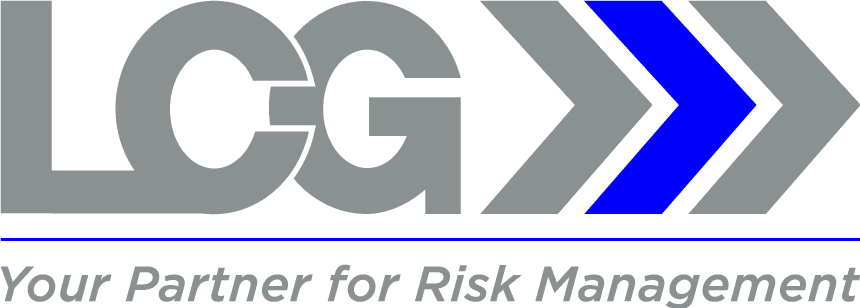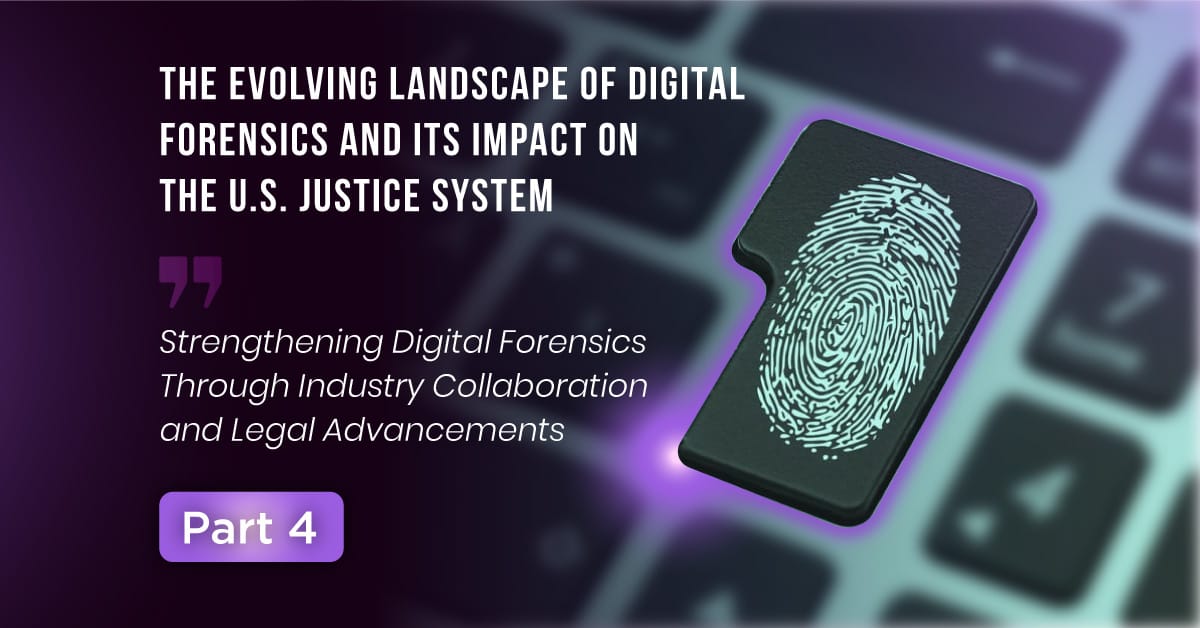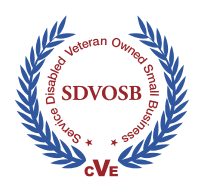Strengthening Digital Forensics Through Industry Collaboration and Legal Advancements
Contributed by: Kris Carlson, LCG COO, Former ICAC Commander, and Digital Forensics Investigator
In our previous installments published on LCG Discovery, we examined the evolving digital forensics landscape, focusing on industry growth, shifts impacting forensic integrity, and the significant consequences arising from inconsistent standards. In our final installment, Part 4, we explore essential strategies for enhancing compliance, improving collaboration between digital forensics and eDiscovery professionals, balancing cost with forensic quality, and expanding educational opportunities for legal practitioners. This forward-looking perspective highlights how collective efforts in industry advancement and legal education can fortify digital forensics as a trusted foundation within the justice system.
The Imperative of Standards in Digital Forensics: Legal, Ethical, and Industry-Wide Implications
Digital forensic standards, anchored in foundational legal doctrines such as the Daubert and Frye admissibility tests, the Federal Rules of Evidence (particularly Rule 702), and the Federal Rules of Civil Procedure, serve as the bedrock for the reliability, admissibility, and overall integrity of digital evidence in judicial proceedings. In addition to these federal mandates, a mosaic of state-level rules and procedural guidelines further underscores the need for methodological consistency and evidentiary rigor.
Yet despite the existence of these well-established legal benchmarks, the digital forensics field continues to suffer from disparate levels of adherence and a lack of uniform enforcement. This inconsistency is not merely academic; it directly jeopardizes the trust placed in forensic evidence by courts, undermines legal outcomes, and weakens the industry’s reputation. The variability in quality and methodology among forensic providers erodes the very credibility that digital evidence is meant to bolster.
Why Uniform Standards Matter
The National Institute of Standards and Technology (NIST) has been unequivocal in its position: consistent adoption of validated practices across forensic service providers enhances both the reliability and defensibility of forensic findings in court. When industry participants coalesce around a unified framework of standards and best practices, the result is a legal environment where judges, attorneys, and jurors can evaluate digital evidence with increased clarity and confidence. This consistency translates into predictability, an essential feature of any well-functioning legal system.
Moreover, widespread adherence to established standards naturally drives a self-regulating evolution in the marketplace. Firms that choose to disregard these standards will face increasing scrutiny. Digital evidence that fails to meet the threshold of methodological or ethical reliability may be deemed inadmissible, suppressed entirely, or discredited under cross-examination. Over time, this creates a “natural selection” effect: firms unable or unwilling to operate at a high standard will find themselves edged out of the industry by legal, reputational, and operational consequences.
The Real-World Consequences of Ethical Breaches
The damage inflicted by rogue actors in the digital forensics space is not theoretical; it is very real. We have personally encountered cases where so-called “experts” have:
- Made unsupported or technically invalid claims in sworn declarations
- Opined on matters well outside their stated area of expertise
- Omitted critical pieces of physical or digital evidence
- Falsified or obscured chain of custody documentation to fit a narrative
These breaches of professional and ethical responsibility not only compromise individual cases but cast a long shadow over the credibility of digital forensics as a whole. When even one firm prioritizes financial incentive over forensic integrity, the entire industry pays the price through judicial skepticism, tighter evidentiary scrutiny, and the erosion of public trust.
Strengthening Adherence to Admissibility Standards
Judicial oversight remains a pivotal factor in maintaining forensic integrity. Courts must enforce adherence to existing admissibility standards by rigorously applying Daubert and Frye tests, ensuring that forensic methodologies are scientifically sound, reliably performed, and appropriately documented. Cases like Kumho Tire Co. v. Carmichael (1999) underscore the judiciary’s critical role in evaluating and safeguarding the reliability of expert testimony in technical disciplines, including digital forensics (Cornell Law School).
The result of such cases has a positive impact on the digital forensics community through prioritizing the consistent use of scientifically validated forensic tools and standardized methodologies. Tools regularly tested and certified by reputable agencies, such as those vetted through NIST’s Computer Forensics Tool Testing (CFTT) Program, offer better reliability and credibility. Furthermore, practitioners should be in the habit of engaging in regular testing of both forensic tools/hardware and engaging in both validation and verification of results.
In the realm of digital forensics, tools are not mere conveniences—they are the instruments by which data is interpreted, evidence is uncovered, and narratives are built. Because these tools often function as a black box to the untrained observer, the responsibility falls squarely on forensic professionals to ensure their scientific and legal integrity through rigorous verification and validation (V&V) processes. Verification answers the question: ” Does the tool work as intended in this specific instance?” Validation answers the question: “Is the tool fundamentally capable of producing reliable results across varied, real-world conditions?“ Each is critical. Neither can be neglected without risking the collapse of evidentiary integrity.
Only when both verification and validation are in place can digital forensic outputs meet the burden of proof required under FRE 702 or state analogs. Failing can lead to evidence suppression, credibility damage, or worse, accusations of negligence or misconduct.
The Critical Need for Strategic Collaboration Between Digital Forensics and eDiscovery Providers
As noted in Part 2 of this series, eDiscovery providers have become increasingly involved in digital forensic matters, often stepping beyond their traditional roles into evidentiary territory. While well-intentioned, this shift frequently exposes a gap in forensic rigor. Many eDiscovery teams operate without the benefit of formal investigative protocols, chain of custody standards, or validated forensic methodology. The result? Compromised evidence, legal exposure, and avoidable downstream challenges. This is not a problem to be ignored, but rather an opportunity for strategic alignment.
To strengthen evidentiary defensibility and enhance the integrity of digital investigations, a partnership between forensic professionals and eDiscovery vendors must become standard practice, not the exception. These are distinct disciplines, but their objectives are intrinsically connected. When forensic and eDiscovery functions operate in silos, it creates workflow gaps, duplicative effort, and greater risk of error or evidentiary challenge. Still, when aligned, they form a seamless continuum from collection to courtroom.
Unified Objectives Require Unified Processes
An interdisciplinary approach, rooted in shared protocols, defined handoffs, and ongoing communication, ensures that digital evidence is preserved, processed, and produced in a manner that satisfies legal, technical, and judicial standards. Forensics provides the foundation of integrity while eDiscovery scales and delivers that evidence for legal review. One cannot succeed without the other. At LCG, we have seen the direct benefits of this model through dual-role engagements. In these scenarios, LCG assumes primary responsibility for:
- Evidence identification, forensic collection, and preservation
- Processing and initial data culling using validated tools and workflows
- Documentation of methodology and custody for courtroom defense
The eDiscovery partner then takes over with:
- Secure hosting and scalable review environments
- Final processing and format-specific productions
- Efficient coordination with counsel for rolling or targeted productions
This model produces tangible benefits, including Stronger evidentiary defensibility: Proper forensic protocols are maintained throughout, reducing the risk of suppression or challenge. Optimized cost structure: By front-loading collection and culling, clients avoid paying high-volume hosting fees for irrelevant data, and Clearer accountability: Defined responsibilities eliminate role ambiguity, ensuring each party operates within their scope of expertise.
Balancing Cost Efficiency with Forensic Quality
Prioritizing Methodology in Provider Selection
Legal teams, insurers, and corporate stakeholders often emphasize cost-efficiency when selecting forensic providers, which can sometimes come at the expense of forensic quality. Yet, ensuring methodological rigor and credibility in forensic practices must take precedence over short-term cost savings. Striking this balance is vital to preserving the reliability and admissibility of digital evidence in court, ultimately minimizing litigation risks and long-term expenses.
To support this balanced approach, the industry should focus on developing cost-effective solutions that do not compromise forensic integrity. This includes implementing scalable, modular service offerings and hybrid forensic models, as previously discussed, alongside leveraging cloud-based and collaborative technologies. By embracing flexible service models that uphold procedural rigor, stakeholders can achieve high-quality digital forensic outcomes within sustainable budgetary constraints.
Forensic Literacy: The Linchpin of Long-Term Viability in Digital Evidence
While much of this final installment has rightfully focused on the forensic operating model, it is imperative to recognize that the model itself is only as effective as the competence of the professionals interacting with it. At the top of the priority list for ensuring the long-term integrity and defensibility of digital forensics is comprehensive education, targeted, standardized, and accessible, for legal and corporate stakeholders alike.
In both civil and criminal contexts, as well as within corporate investigations, decisions are increasingly being made on the basis of complex digital artifacts, artifacts that can be misinterpreted, manipulated, or dismissed if the evaluator lacks even a basic grounding in forensic principles. The absence of forensic literacy among attorneys, judges, and corporate decision-makers poses a direct threat to fair adjudication and sound business risk management. Digital forensics is a specialized discipline and should be treated as such, as strict standards, nuanced methodologies, and technical limitations govern it. Yet too often, the professionals charged with evaluating this evidence (counsel, judges, and executives) are forced to rely on intuition, not training. This is unsustainable.
When those tasked with formulating life-changing decisions do not understand at its core what forensic analysis/tools can and cannot do, the result is evidentiary overreach, unreliable expert testimony, and flawed judicial outcomes. When corporate clients lack insight into forensic capabilities, they expose themselves to poor vendor choices, costly missteps, and legal exposure.
Institutional Education: What’s Needed Now
Institutions such as the Federal Judicial Center, state judicial training programs, and professional organizations have made commendable efforts to close the education gap. But what’s new is scale, consistency, and customization. Recommended program components should include:
- Core principles of digital forensics (acquisition, preservation, chain of custody)
- Tool limitations and interpretive boundaries
- Evaluating the validity of expert testimony
- Legal admissibility standards (Daubert, FRE 702, etc.)
- Common pitfalls in the use or presentation of digital evidence
These educational offerings must go beyond passive CLEs and scattered workshops. We need structured, credentialed programs with clear learning outcomes and practical case-based application, not only for the legal bar but for corporate GCs, compliance officers, and incident response teams.
Final Thought
As digital forensics continues to evolve, balancing efficiency, accessibility, and forensic integrity becomes increasingly vital. Strengthening industry standards, fostering interdisciplinary collaboration, reinforcing legal compliance, and enhancing educational outreach will position digital forensics to adapt effectively to technological advancements and judicial expectations. By collectively committing to these strategies, forensic experts, legal professionals, and corporate stakeholders can ensure digital evidence remains a reliable, respected, and indispensable pillar of the justice system.
Thank you for joining our thought leadership series at LCG Discovery. Together, let’s continue to advocate for excellence in digital forensic practice and maintain the highest standards of evidentiary integrity within the evolving judicial landscape.







